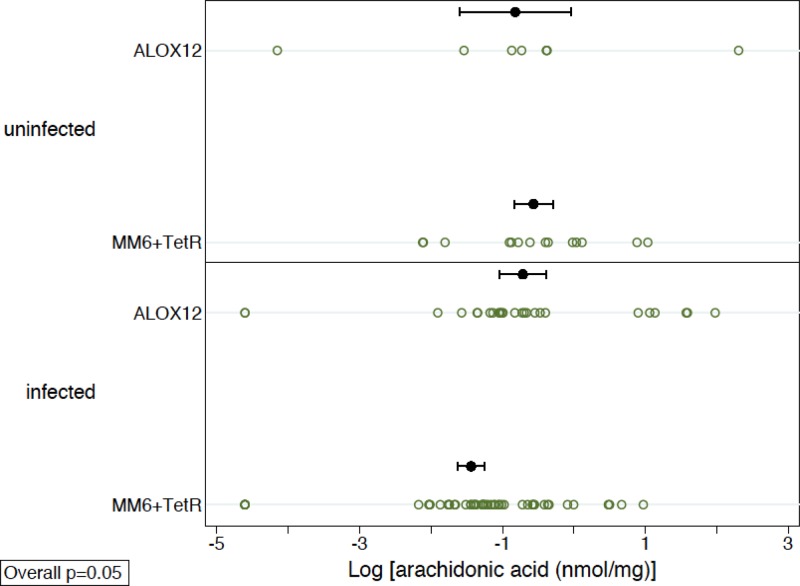FIG 2.
Quantitation of arachidonic acid levels in wild-type MonoMac6 cells (MM6) and in MonoMac6 cells engineered to express either a lentivirus shRNA that knocks down ALOX12 or a control, off-target lentivirus shRNA that knocks down TetR. The data are from a minimum of five independent experiments. Error bars indicate standard errors. The mean arachidonic acid levels (standard errors of the means) are 1.78 (±1.38) nmol/mg for uninfected cells and 1.27 (±0.37) nmol/mg for infected cells in the ALOX12 knockdown group, 0.97 (±0.43) nmol/mg in uninfected cells and 0.44 (±0.10) nmol/mg in infected cells in the wild-type group, and 0.72 (±0.13) nmol/mg in uninfected cells and 0.41 (±0.09) nmol/mg in infected cells in the TetR siRNA group. When the MM6 and TetR siRNA groups are combined as the ALOX12 wild-type group, the mean arachidonic acid levels (standard errors of the means) are 0.85 (±0.22) nmol/mg in uninfected cells and 0.43 (±0.07) nmol/mg in infected cells. Uninfected cells with ALOX12 shRNA, no shRNA, or TetR shRNA are shown. Cells infected with T. gondii for 24 h that show the same pattern of shRNA for ALOX12 have higher levels of the substrate, arachidonic acid, than wild-type MonoMac6 cells and off-target shRNA controls. The results listed here in the figure legend are with the raw, untransformed data. The graph, on the other hand, is plotted using log-transformed data. For each cell type, the number of uninfected- and infected-cell samples combined was 32, 34, or 32, respectively. Due to evidence of nonnormality, nonparametric tests were used. Since the MM6 and TetR groups were similar, they were combined and compared to the ALOX12 group. In an overall analysis, stratified by infection status, the ALOX12 group had significantly higher values than the MM6-plus-TetR group (P, 0.05 by a stratified Wilcoxon rank-sum test).

